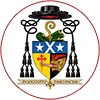Daily homilies by the Prior of Pluscarden at the Quarr Abbey Retreat, 5-12 October 2016
Homily for Friday Week 27 Year II, 7 October 2016, The Feast of the Holy Rosary
Acts 1:12-14; Luke 1:26-38
After Jesus had ascended into heaven, the Eleven Apostles, with some few others, with one heart and mind, joined together in continuous prayer.
This is the first picture given us in the Acts of the Apostles of the early Church: the Church in seed, the Church in her first beginnings, at her well spring. Among that small group united with the Apostles, as St. Luke tells us, was Mary the Mother of Jesus. Doubtless St. Luke gave Our Lady no more than a passing mention here out of deference to her expressed wishes: to remain wherever possible in the background, not to be too much noticed, too much praised, beyond the necessity of Gospel truth.
Yet this passing mention is enough. The Mother of Jesus had to be present in that early group: for Mary was and remains at the heart of the Church. She is at once the symbol of the whole Church, and the Church’s Mother. Mary was present then, and remains present now, for she is essential for the Unity, and Holiness, and Catholicity of the Church. Also, crucially, Our Lady was there while the Church prayed. Her presence in the Church’s prayer has never ceased, and will continue on, uninterrupted, until the end of time.
Today is the Feast of the Holy Rosary, celebrated by the Latin Church in her General Calendar. In this way the Church very officially underlines her approbation of the prayer of the Rosary, and her ever continuing desire to promote it.
Today’s Gospel presents us with the first joyful mystery of the Holy Rosary: the Annunciation of the Lord. Once again, we read of how the Son of God became incarnate at the graced and free assent of his holy Mother. And once again we hear the greeting of the Angel to Mary, which gives us the opening words of the Hail Mary.
These words are continually repeated as the prayer of the Rosary unfolds. Again and again, in the words of the Angel, the faithful greet Our Lady, and honour her, and call upon her, and ask for her prayers. We ask her help, that we may be where she is; that she may help us approach her own relationship with God; that we may imitate her own cooperation with his redeeming work.
Threaded on a circular string or chain, the repeated Hail Marys draw the faithful through all the mysteries of Christ, in ordered succession. Through Mary, with Mary, and in Mary, we meditate on the joyful mysteries of Jesus, then the luminous mysteries, then the sorrowful mysteries, and finally the glorious mysteries.
The Rosary is a very good method for staying close to the way God has given us to come to him. We reach the divinity through the humanity of Jesus: this humanity which he drew from his holy Mother. So we come to Jesus in a human way, humanly. Actually there is no other way to God. I am the way, the truth and the life, said Jesus. No one comes to the Father except through me (Jn 14:6).
The Rosary can be recited either in a group or by an individual. Personally I find it extremely helpful while passing through airports, or train stations, or while waiting for an appointment, or while walking along, whether down a cloister or a country lane or a street. The Rosary is also helpful as a method of silent, focussed meditation; also as a vehicle for thanksgiving or petition; also as a way into the prayer of contemplation.
Our aim, according to the teaching of Holy Scripture (cf. 1 Thess 5:17), must always be to approach a state of ceaseless prayer: by whatever method, or by no method at all. According to the best spiritual advice and instruction, confirmed by the experience of the Saints, and surely by our own experience, Our Lady is an essential ingredient in such prayer. We could define “prayer without ceasing” in other terms: unimpeded union with Jesus; love that is unsullied, unselfish and ever active; complete freedom given to the Holy Spirit to have possession of our heart. Of course this simply describes Our Lady as she always was and will ever be. But remove her from our own prayer, and immediately we lack not only her feminine motherliness, but also her intimacy with her divine Son. The humanity of Jesus, without his Mother, becomes attenuated into an abstraction. God becomes distant, remote. Our relationship to him becomes merely that of creature bowing down before its Creator. The heart remains unengaged, and true religion easily slides off into something less than itself; even into mere ideology.
As one little way of praising and thanking Our Lady, and especially for the gift of the holy Rosary, I mention now finally the last of the glorious mysteries, her Coronation as Queen of Heaven.
This was a favourite subject for paintings and carvings over Altars or Church doors in the High Middle Ages. And rightly so. For it is not merely a legendary addition to scriptural faith, but on the contrary a summary of the whole mystery of salvation. In the heavenly triumph of Mary, Christ’s victory is completed. The humble is exalted; God’s promise is fulfilled; his Mother who was greeted at the beginning by an Angel is now enthroned higher than all the Angels. May she from her heavenly height continue to pray for us: that through her intercession, and by her example, we too may be made worthy of the promises of Christ.
